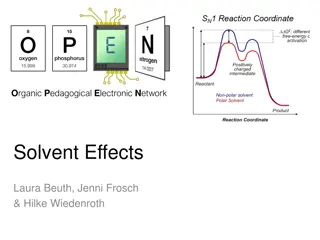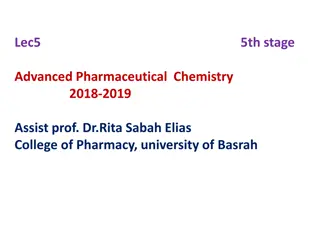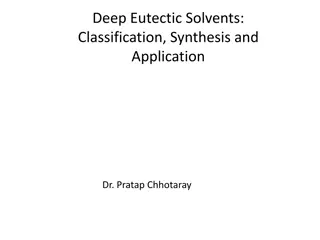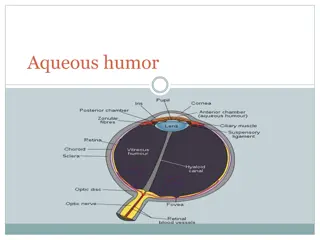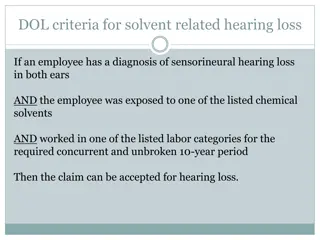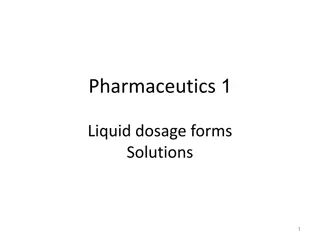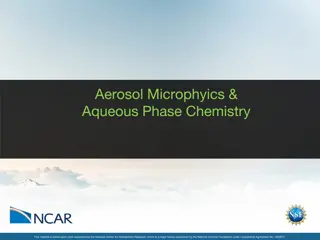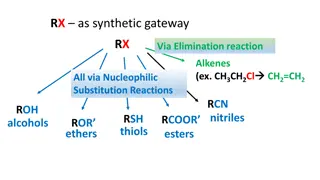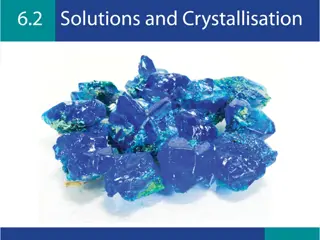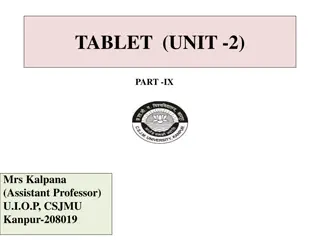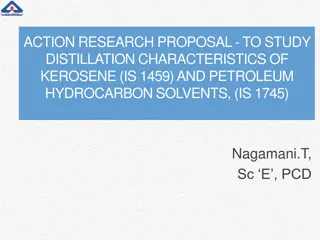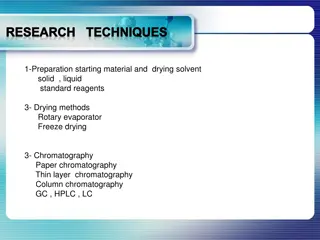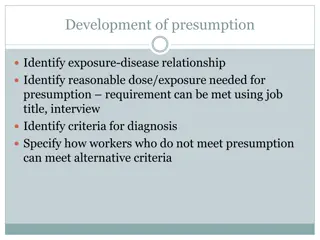Understanding Non-Aqueous Solvents: Types and Classification
Inorganic non-aqueous solvents play a crucial role in chemical research and industry. This article by Dr. Princy K.G. delves into the classification of solvents based on protonicity, polarity, and aqueous vs. non-aqueous nature. It explores the types of non-aqueous solvents, such as protonic and non-protonic solvents, and discusses protic, aprotic, acidic, basic, and ionising solvents. The insightful content provides a comprehensive understanding of non-aqueous solvents and their significance in various chemical processes.
Download Presentation

Please find below an Image/Link to download the presentation.
The content on the website is provided AS IS for your information and personal use only. It may not be sold, licensed, or shared on other websites without obtaining consent from the author. Download presentation by click this link. If you encounter any issues during the download, it is possible that the publisher has removed the file from their server.
E N D
Presentation Transcript
NON AQUEOUS SOLVENTS Dr. PRINCY K.G. ASSOCIATE PROFESSOR DEPARTMENT OF CHEMISTRY CARMEL COLLEGE, MALA
INTRODUCTION :- ? An inorganic nonaqueous solvent is a solvent other than water, that is not an organic compound. examples are liquid ammonia, liquid sulfur chloride and sulfurychloride phosphoryl chloride, dinitrogen tetroxide, antimony trichloride, bromine pentafluoride, hydrogen fluoride, pure sulfuric acid and other inorganic acids. These solvents are used in chemical research and industry for reactions. dioxide, sulfuryl fluridef,
CLASSIFICATION OF SOLVENTS ? Classification of solvents based on proton. ? Classification of solvents based on polar and non-polar solvents. ? Classification of solvents on Aqueous and non- aqueous solvents
TYPES OF NON AQUEOUS SOLVENTS: 1)PROTONIC AND NON PROTONIC SOLVENTS- THE SOLVENTS FROM WHICH PROTONS CAN BE DERIVED ARE CALLED PROTONIC SOLVENTS. eg. WATER, SULPHURIC ACID. THE SOLVENTS FROM WHICH PROTONS CAN NOTBE DERIVED ARE CALLED NON PROTONIC SOLVENTS. eg. LIQUID SULPHUR DIOXIDE, BENZENE, CHLOROFORM.
? Protic or protonic solvents :- 2NH NH + (ammonium) + NH (amide) 3HF H F+ + HF - (hydrogen difluoride) 2H SO H SO + + HSO - (A)Acidic or protogenic solvents. H SO ,HCl, CH COOH ,HCN. (B) Basic or protophilic solvents. NH , N H . ? Aprotic or non- protonic solvents:- ? C H ,CHCl ,CCl ,SO . N O NO+ (nitrosonium) + NO (nitrate) 2SbCl SbCl + (dichloroantimonium) + SbCl - (tetrachloroantimonate) POCl POCl + + POCl -
2 . ACIDIC ,BASIC OR AMPHIPROTIC SOLVENTS:- ? The solvents which have a tendency to donate protons are acidic in nature and are called acidic solvents .Eg. Acetic acid ,HF. ? The solvents which have strong tendency to accept protons are basic in nature and are called basic or protophilic solvents. Eg.Liquid NH , C H N(Pyridine) etc. ? The solvents which neither have tendency to gain nor to lose protons are called amphiprotic or amphoteric solvents. Eg.H O,C H OH, etc.
3.IONISING AND NON IONISING SOLVENTS:- The solvents which are capable of undergoing self ionisation(auto- ionisation)are called ionising solvents. eg.H O,NH ,SO , etc. The solvents which do not ionise at all are called non-ionising solvents. Eg. Benzene,hydrocarbons etc. -These are non-polar in nature.
4.CO-ORDINATING AND NON CO- ORDINATING SOLVENTS :- The solvents which are capable of coordinating with the metal ions or anions of the solute are called co-ordinating solvents. eg. NH , SO ,DMSO, DMF etc. On the other hand, the solvents which are not capable of co-ordinating with the metal ions are called non co-ordinating solvents. eg.CCl , Saturated hydrocarbons etc.
PHYSICAL PROPERTIES OF SOLVENTS:- ? Melting point and boiling point. ? Dielectric constant. ? Viscosity. o Dipole moment. o Heat of fusion & Heat of vaporisation. Mn(VII) Cr(VI) V(V)
LIQUID AMMONIA as an non- aqueous solvent:- PHYSICAL PROPERTIES:- Freezing Point:- Boiling Point:- Dielectric Constant:- 22.0 at -33.5 Liquid Range:- Heat of Fusion:- Heat of Vaporisation:- 23.6 kj Mol Self Ionisable in Nature Acts as an associated Solvent -77.7 -33.38 -77 to -33 0.018 kj Mol
WHY AMMONIA ACTS AS A BETTER SOLVENT THAN WATER:- Poor conductor of electricity Specific heat of ammonia is greater than water Less viscous than water High critical temperature and pressure Less associated than water(due to lesser hydrogen bonding) Due to formation of strong reducing Metal ammonia solutions with alkali Metals.
CHEMICAL REACTION ? Acid base reaction. ? Precipitation reaction. ? Redox reaction. ? Solvation reaction.
TYPE OF REACTIONS IN NON AQUEOUS SOLVENTS:- 1) METATHETICAL OR PRECIPITATION REACTIONS:- The reactions in which precipitation occurs on mixing two solutions are called metathetical or precipitation reactions. For example, in H O ,silver nitrate and barium chloride react to give a precipitate of silver chloride leaving barium nitrate in the solution. 2AgNO + BaCl 2AgCl + Ba(NO )
2) SALT FORMATION :- The reactions between appropriate acidic and basic substances to form salts are called salt formation reactions. For eg, sodium Ureide can not be prepared by the action of urea on sodium hydroxide in water(because strong base can not take proton from urea molecule). Na (NHCONH ) + H O Na OH + NH CONH (SODIUM UREIDE) (UREA) However,this can be easily formed in Liq.NH by reaction of urea with sodamide. NH CONH + Na NH Na (NHCONH ) +NH (UREA) (SODAMIDE) (SODIUM UREIDE)
3)ACID BASE REACTIONS :- ? Acid base reaction can be explained on the basis of solvent system concept ? An acid is a substance that by direct dissociation or reaction with the solvent gives the cation chacteristic of the solvent.Similarly, ? A base is a substance that gives the anion characteristic of the solvent. ? For eg, in liq. Nh solvent ,nh ion act as acids and nh ions act as bases. The neutralisation reaction is:- NH Cl + NaNH NaCl + 2NH Acid Base Salt Solvent ?
4) SOLVOLYTIC REACTIONS OR SOLVOLYSIS :- ? The reactions in which the solvent molecules react with the solute in such a way that the solvent molecules split up into two parts, one or both of which get attached to the solute molecule or ion are called solvolytic reactions. ? WATER AS SOLVENT:- 2H O H O + OH (AUTO IONISATION ) SO Cl + 4 H O SO (OH) + 2H O +2Cl F +H O HF +OH ? AMMONIA AS SOLVENT :- 2NH SO Cl + 4 NH SO (NH ) + 2NH + 2Cl H + NH NH + H NH + NH
5) SOLVATION REACTION :- ? Solvent get attached to a solute species( cation , anion , or molecule) are called solvation reactions.The species formed is called solvate. ? CuSO + 4NH CuSO .4NH (AMMONIATE) ? CuCl + 4 H O [ Cu (H O) ] +2 Cl (HYDRATE) ? BaSO + 3 H SO BaSO .3H SO (SOLVATE OF SULPHURIC ACID)
REACTIONS IN LIQUID AMMONIA 1)ACID BASE REACTIONS:- LIQUID AMMONIA IONISES AS:- 2NH NH + NH FOR eg. KNH K +NH PROTOLYSIS REACTION:- Certain Compounds like UREA which are incapable of donating pprotons to water can readily donate proton to ammonia in liquid amonia . NH NH \ C = O + NH C = O + NH NH NH \
2) ACID BASE NEUTRALISATION REACTION:- ? Neutralisation of an acid and base in liquid ammonia involves combination of NH ion(from acid) and NH ion(from base):- NH CI + KNH KCI +2NH ACID BASE NH + NH 2NH ? AS AN ACID:- Zn(OH) + KOH K Zn(NH ) ? AS A BASE:- Zn(NH ) +2NH CI ZnCI + 4NH
3) PRECIPITATION REACTIONS:- ? Precipitation decomposition solubilities. ? Silver chloride precipitated in aqueous solution as:- KCl +AgNO AgCl + KNO reactions because involve the double of differences in ? White PPT of BaCl is produced when silver chloride and liq. ammonia brought together :- 2AgCl+ Ba(NO ) BaCl (ppt)+ 2AgNO
4) AMMONOLYSIS REACTION:- ? The solvolysis reactions in liquid ammonia are called ammonolysis or ammonolytic reactions. ? For eg. Hydrolysis of SiCl occurs as:- SiCl +4H O Si(OH) (Silicic acid) ? Organic halides undergo slow ammonolysis reaction to form ammines :- RX + 2NH RNH + NH X (Primary amines)
5) SOLUTIONS IN LIQUID AMMONIA:- ? The most striking property of liquid ammmonia is its ability to dissolve alkali metals.The resulting solutions are blue and good electrical conductors. ? When alkali metals are dissolved in liquid ammonia they ionise to give metal ions and valence electrons as:- Na Na + e ? Both alkali metal and electron become solvated by ammonia molecules.
Na + xNH [ Na(NH)x] (ammoniated cation) e + yNH [ e(NH )y] (amnoniated electron ) ? The complete reaction may be written as:- Na [ Na (NH )x] + [ e (NH )y] ? The ammoniated electrons are responsible for blue colour of solution.
LIQUID SULPHUR DIOXIDE :- ? It is a non protonic solvent or aprotic solvent because it does not contain any hydrogen atom. ? It is alspo one of the important non aqueous solvent and widely used in industry. ? Physical properties of liquid SO :- ? Freezing Point :- -75.46 ? Boiling Point :- -10.02 ? Dielectric constant: - 17.40
REACTIONS IN LIQUID SO :- 1) ACID BASE RACTION :- Liquid SO undergo auto ionisation as : 2SO SO + SO Acid Base or Neutralisation reaction in liquid SO may be given as:- SOCl + Cs SO 2CsCl + 2SO (ACID) (BASE)
2) SOLVOLYTIC REACTIONS :- ? Solvolytic reactions in liquid SO are not so common as hey are in other solvents such as NH . ? Certain covalent halides such as PCl ,PBr , WCl under go solvolysis in liquid SO in sealed tubes. ? PCl + SO (liq) POCl + SOCl ? PBr + SO (liq) POBr + SOBr ? WCl +SO (liq) WOCl + SOCl
3) PRECIPITATION REACTIONS :- ? Precipitation of several insoluble compounds in liq. Sulphur dioxide can be carried out by treating with soluble compound in SO . SbCl + 3LiI SbI + 3LiCl AlCl + 3NaI 3NaCl + AlI
4) REDOX REACTIONS :- ? Liq. Sulphur dioxide does show any marked reducing or oxidising property. It simply act as a medium for certain redox reactions. 6KI + 3SbCl 2K [SbCl ] + SbCl + 3I


